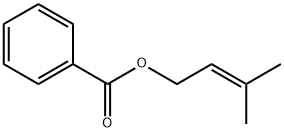2,4,5-TRIMETHYLANILINE
- CAS NO.:94-48-4
- Empirical Formula: C17H22O2
- Molecular Weight: 258.36
- MDL number: MFCD00036513
- EINECS: 202-337-0
- SAFETY DATA SHEET (SDS)
- Update Date: 2024-12-18 14:15:30

What is 2,4,5-TRIMETHYLANILINE?
Description
Geranyl benzoate has a sweet, light odor reminiscent of ylangylang. It may be synthesized from geraniol and benzoyl chloride in anhydrous pyridine; also from geraniol and benzoyl chloride using the Schotten-Bauman reaction.
Chemical properties
Geranyl benzoate has a sweet, light odor reminiscent of ylang-ylang.
Occurrence
Has been reported in ylang ylang oil (Gildemeister & Hoffman, 1960).
Preparation
From geraniol and benzoyl chloride in anhydrous pyridine; also from geraniol and benzoyl chloride using the Schotten– Baumman reaction.
Definition
ChEBI: Geranyl benzoate is a benzoate ester resulting from the formal condensation of the carboxy group of benzoic acid with the hydroxy group of geraniol. It has a role as a plant metabolite and a fragrance. It is a benzoate ester, a monoterpenoid and an olefinic compound. It is functionally related to a geraniol and a benzoic acid.
Properties of 2,4,5-TRIMETHYLANILINE
| Boiling point: | 305 °C(lit.) |
| Density | 0.996 g/mL at 25 °C(lit.) |
| refractive index | n |
| FEMA | 2511 | GERANYL BENZOATE |
| Flash point: | >230 °F |
| Odor | at 100.00 %. sweet amber ylang rose |
| JECFA Number | 860 |
| CAS DataBase Reference | 94-48-4(CAS DataBase Reference) |
| EPA Substance Registry System | 2,6-Octadien-1-ol, 3,7-dimethyl-, benzoate, (2E)- (94-48-4) |
Safety information for 2,4,5-TRIMETHYLANILINE
Computed Descriptors for 2,4,5-TRIMETHYLANILINE
New Products
Tert-butyl bis(2-chloroethyl)carbamate (S)-3-Aminobutanenitrile hydrochloride N-Boc-D-alaninol N-BOC-D/L-ALANINOL N-octanoyl benzotriazole 3,4-Dibenzyloxybenzaldehyde 4-Hydrazinobenzoic acid 1,1’-CARBONYLDIIMIDAZOLE R-2-BENZYLOXY PROPIONIC ACID 3-NITRO-2-METHYL ANILINE 4-IODO BENZOIC ACID 4-HYDROXY BENZYL ALCOHOL 4-(3-chloropropyl)morpholine phenylhydrazine hydrochloride (2-Hydroxyphenyl)acetonitrile 4-Bromopyrazole 5-BROMO-2CYANO PYRIDINE 5,6-Dimethoxyindanone 5-broMo-2-chloro-N-cyclopentylpyriMidin-4-aMine 4-methoxy-3,5-dinitropyridine 2-(Cyanocyclohexyl)acetic acid 2-aminopropyl benzoate hydrochloride 1-(4-(aminomethyl)benzyl)urea hydrochloride tert-butyl 4- (ureidomethyl)benzylcarbamateRelated products of tetrahydrofuran








You may like
-
 (9H-fluoren-9-yl)methyl (2,5-dioxopyrrolidin-1-yl) carbonate 82911-69-1 98.0%View Details
(9H-fluoren-9-yl)methyl (2,5-dioxopyrrolidin-1-yl) carbonate 82911-69-1 98.0%View Details
82911-69-1 -
 13057-17-5 95.0%View Details
13057-17-5 95.0%View Details
13057-17-5 -
![2-Nitro-8,9-dihydro-5H-benzo [7] annulen-7(6H)-one 98.0%](https://img.chemicalbook.in//Content/image/CP5.jpg) 2-Nitro-8,9-dihydro-5H-benzo [7] annulen-7(6H)-one 98.0%View Details
2-Nitro-8,9-dihydro-5H-benzo [7] annulen-7(6H)-one 98.0%View Details
740842-50-6 -
 4-bromoaniline 106-40-1 99.0%View Details
4-bromoaniline 106-40-1 99.0%View Details
106-40-1 -
 1421517-99-8 99.0%View Details
1421517-99-8 99.0%View Details
1421517-99-8 -
 5-bromo-2-chlorobenzoic acid 99.0%View Details
5-bromo-2-chlorobenzoic acid 99.0%View Details
21739-92-4 -
 2-methyl-5-nitrophenol 98.0%View Details
2-methyl-5-nitrophenol 98.0%View Details
5428-54-6 -
 15761-38-3 97.0%View Details
15761-38-3 97.0%View Details
15761-38-3